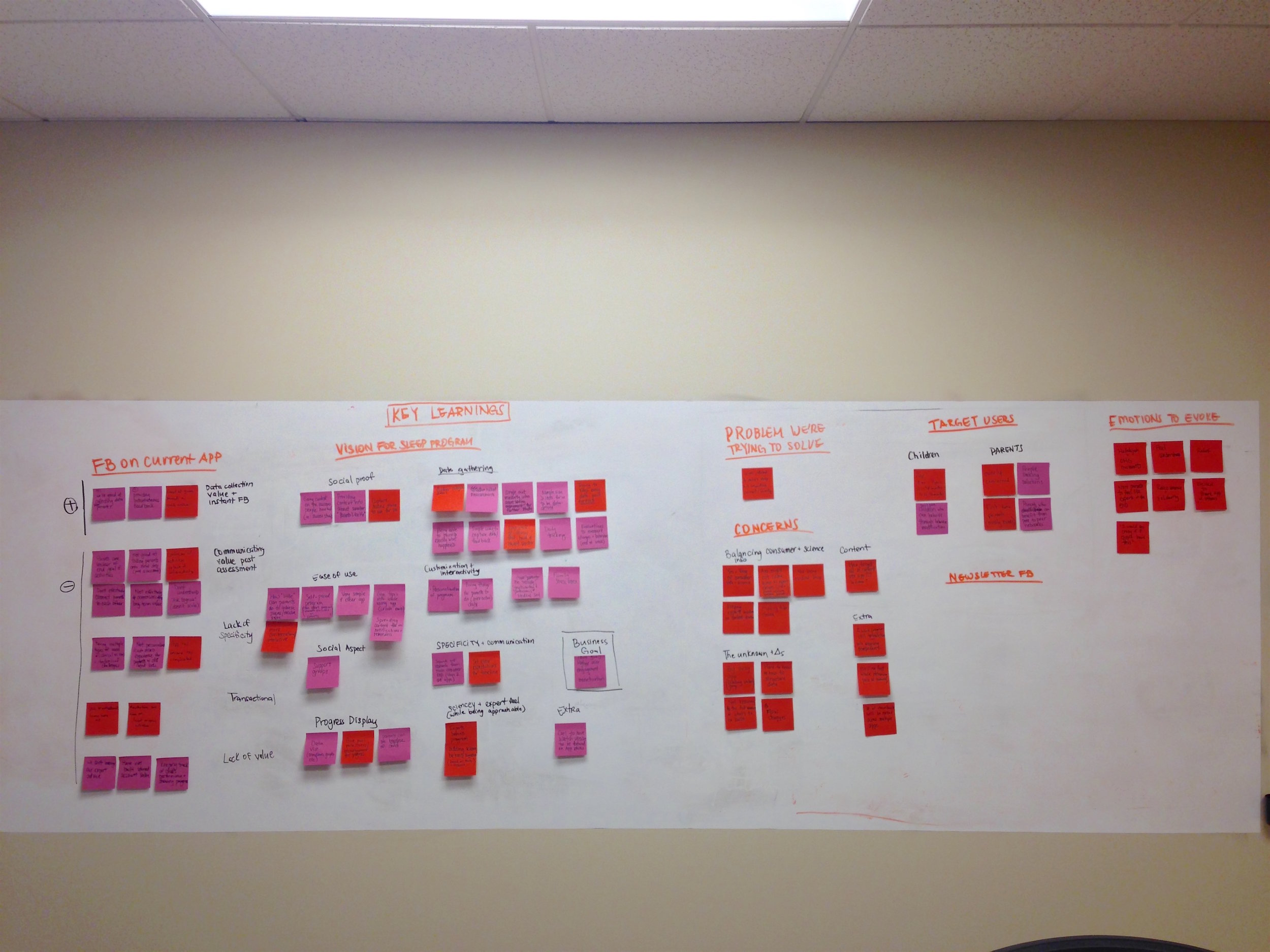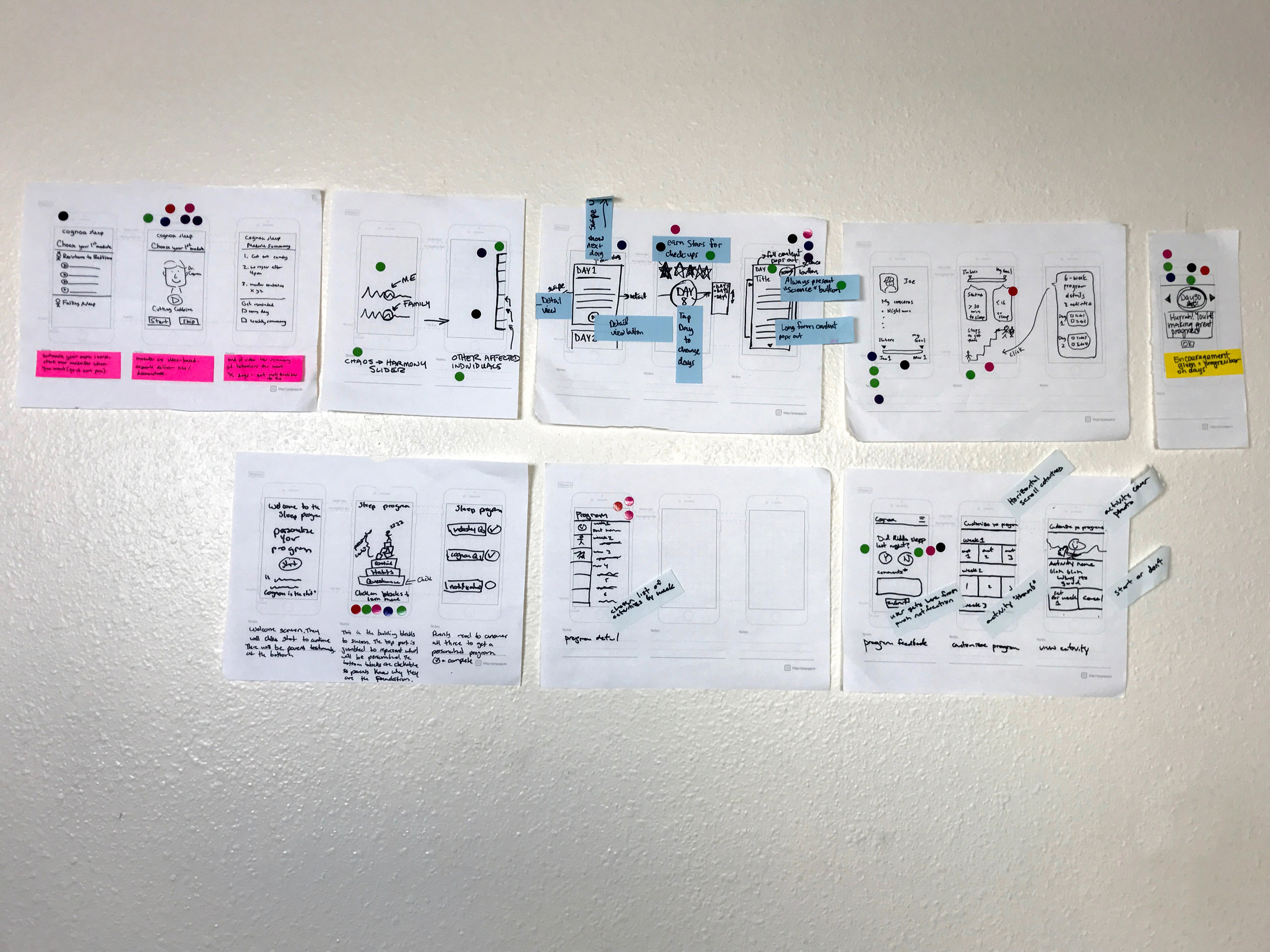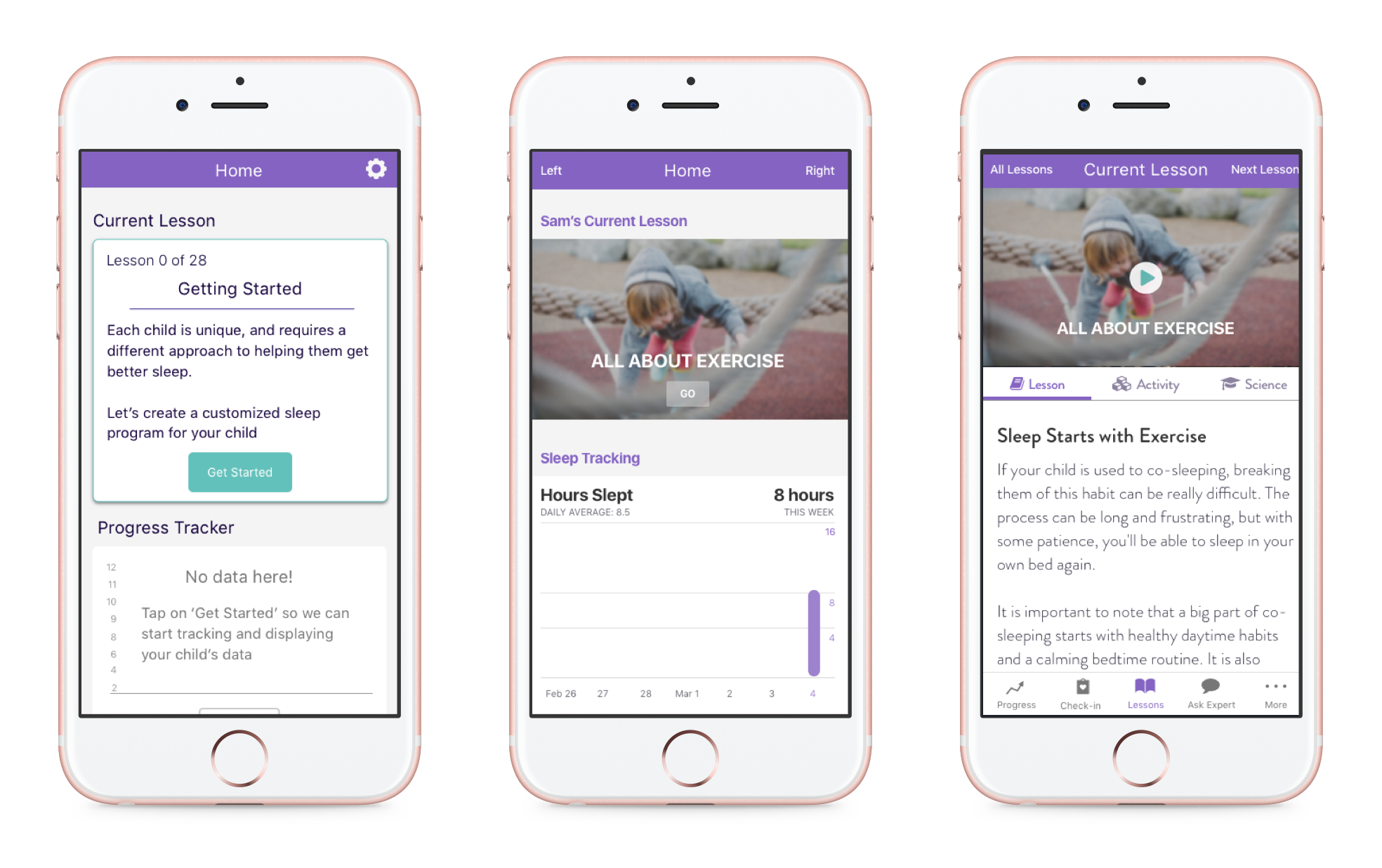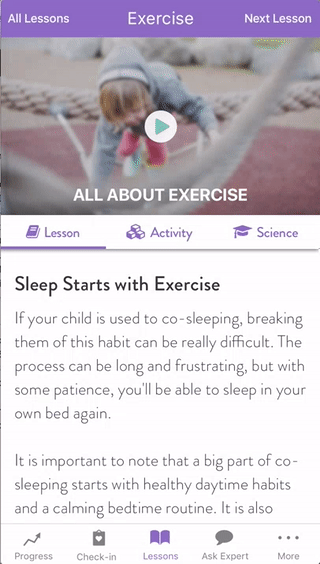Cognoa Sleep Coach
Helping parents get their little ones to sleep
TLDR
Over the span of 8 months, my team of one other designer created a fully functional educational & sleep-tracking app to aid parents in helping their young children sleep better at night.
OVERVIEW
Getting young children to sleep throughout the night is one of the most common (and frustrating) issues that parents face. We saw an opportunity to serve over 30% of our user base of (150,000 parents strong) who have reported problems with getting their children to sleep. Collaborating with leading sleep experts in top research institutions in America, and continuously going back to our users to validate our ideas, my team was able to create a stand-alone supplementary app to complement Cognoa’s diagnostic tool for child development, to support parents in their greatest area of need.
SCOPE
Built an entire iOS app as Cognoa's first attempt to delve into building our first digital therapeutic product to market.
ROLE
I kicked off the sleep app design process, led and conducted all user-testing for our product, and did the wireframes and visual designs.
TIMELINE
February - December 2016
Array of screens
THE CHALLENGE
The main challenge that we were faced with was to create a product that felt personalized and not a regurgitation of information that parents can easily find online.
GOAL
We wanted to create a standalone app that would help a large section (over 30%) of our user base with reported concerns about getting their children to sleep. Using the GV design sprint to jumpstart the process involving everyone in our company while working closely with parents for feedback, we were able to develop an app that will change the way children and parents sleep.
PROCESS
UNDERSTANDING THE PROBLEM
PROFILE: COGNOA'S USERS
First-time mothers
A large percentage of our users are first-time mothers who are concerned about their child's developmental well-being.
Do own parenting research
90% of parents who experience difficulty with their children's sleep consult online and offline resources to help resolve sleep-related issues, but have no clear direction on what to do.
Need for simplicity
Parents lead very busy lives rearing their young, while providing for their families.
Privacy
Parents are only willing to share information about their child if they trust a product and can derive value from it.
NEEDS FINDING
We found that 30% of our user base of over 150,000 parents have expressed concerns with their children's sleep. Through behavioral and exploratory interviews, we identified that there was an underserved market with an overwhelming majority (90%) of parents who were actively seeking for ways to help combat their issues with children's sleep.
During our interviews, we also had parents express interest in being able to track their child's sleep and see improvements with time.
VISION
Our vision is to be the ultimate resource for parents to get help in addressing their children's sleep issues.
We wanted to provide parents with a simple and delightful product that does more than just regurgitate information easily found online back to them. We sought to create a mobile iOS experience that would not only serve to educate parents but also provide them with a way to track their child's sleep improvements with time through progress tracking.
As our typical parent user lives a very busy and exhausting life, it was very important for us to deliver information efficiently in an effective and simple manner.
Additionally, we wanted our parent users to feel safe and secure with using our app by providing them with a delightful and personal experience throughout their journey.
PROCESS
Synthesis of stakeholder insights for the Sleep App
GOOGLE VENTURE DESIGN SPRINT
Following GV's design sprint process, I collected knowledge and perspective from every major stakeholder in our company to help us sync up on potential concerns and limitation with our proposed product.
Using the learnings from speaking with them, and engaging in an all-team sketching session, I rapidly built a prototype with another designer and tested our hypotheses and ideas by conducting in-person testing on target-users that I recruited.
PROTOTYPING & VALIDATING IDEAS
We continued to iterate upon and validate our ideas through consistent weekly user testing of all sorts- remote, in-person, and internal testing with parents in our team. I shared our findings with our team and encouraged them to share their thoughts, which allowed us to view our product from multiple angles.
DESIGNS
Some sketches from the design sprint
Selected sketches: left (icon exploration) middle (progress tracker & program overview), right (questionnaire)
Design System
We created a design system to help us create a cohesive component library among the sleep app, allowing for faster collaboration and iteration.
Snippet of our style guide
QUESTIONNAIRE
For our sleep app to be an established tool that sleep therapists could use to supplement their services, we needed to be able to prove that our product can successfully help parents get their children to sleep better. Partnering with a number of sleep therapists to use our app in their practice as a form of treatment, we used the same set of questions they used in order to be able to compare our results. Our challenge was then to translate a lengthy paper questionnaire (one that you would fill out in doctor's offices) into a mobile experience.
Our questionnaire was originally designed to mimic the experience of answering down a list of questions, making each question accessible to users at any point, and allowing users to progress to the next section by clicking on "Next" at the end of the page. We also added a progress bar on top to give users a visual sense of how much more they had to go.
We iterated upon this design to optimize for a smooth and delightful user-experience by serving up questions individually and anchoring the progress bar & the original prompt at the top, leading to a two-fold increase in user completion rate, and a complete elimination of user error.
Video reel from a user testing session of our first questionnaire iteration showing user getting confused with how to proceed.
HOME PAGE
Home page iterations from left (oldest) to right (current)
We initially designed the home screen with the belief that busy parents wanted to be able to immediately see where they are in their sleep program, and identify what they had to do first. The initial version of the home page had a summary of the child’s sleep progress, and displayed their most current lesson.
Through user testing, we determined that most parents were mostly interested in learning about the next lesson and with picking up where they left off as they wanted to be able to learn how they can improve their child’s sleep first and foremost, above all other features. The new home screen therefore reflected that need and showcased the current lessons, allowing parents to quickly take a deep-dive into their lessons.
LESSONS
The initial concept for this feature was based on one of our major learnings from talking to parents— that they wanted a product that would be customized to their needs and concerns, while being given content that was different from information that can be easily found online.
Before designing the sleep app, we validated our feature concept through an email program where parents received a lesson and activities each day for 4 weeks. Through this MVP pilot, we were confident to pursue the mobile version of this program and knew that the lesson progression within the app worked because of the success our email prototype had, where 94% of parents showed an improvement in their child's sleep.
As personalization was a huge value that our users were looking for in our product, we designed the lessons to only show parents relevant content. We presented the lessons in the order that was reflective of the responses that they entered on their initial questionnaire.
To address user feedback that lengthier lessons were much harder to comprehend, we added summary videos and relevant media to our longer and more technical lessons, allowing parents to consume content through more engaging and faster means.
DAILY CHECK-INS
One of the essential features of our app was our progress tracking feature. We not only wanted parents to be able to learn about the science and various ways that can help improve their child’s sleep, but we also wanted parents to be able to easily track and measure the progress of their child’s sleep.
Using key questions that were absolutely critical to measure the level of success of our users and their children, we created the daily check-in feature that allowed users to easily input information about their child's sleep the night before in only a few minutes. We envisioned this feature to be a quick and easy reflective journal and were pleasantly surprised that all parents we spoke to were not at all deterred by the number of questions, so long as they were simple and easy to answer, and that they could easily visualize their progress from their daily entries.
USER FLOWS
I created several kinds of flows to map out the user's journey, to define the notification and permissions logic, and to give myself and our developers clarity to how one screen flows to the next.
One among several annotated user flows I created
NEXT STEPS
Although the sleep app was ready for release on the app store, a business decision was made to move towards creating a full-stack app instead of creating multiple mobile products.
My next steps moving forward are to to focus on integrating the content and learnings from this experience into our main app to provide a more holistic and valuable resource for parents seeking guidance on their child's development.


















